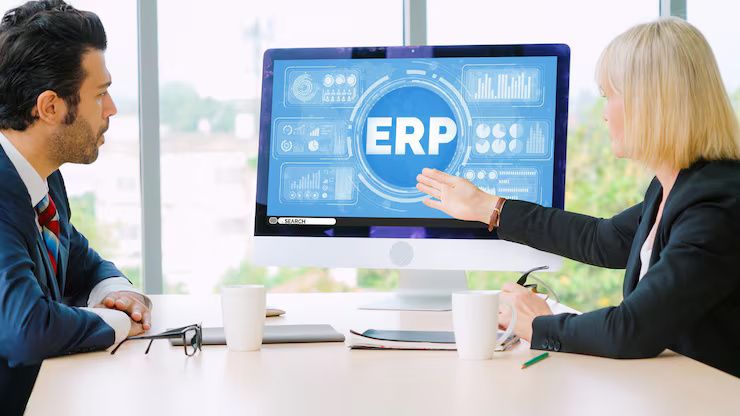Explore How ERP Systems Improve Workflow Efficiency: A Complete Guide
Enterprise Resource Planning (ERP) systems are comprehensive software platforms that integrate and manage core business processes in real time. They exist to simplify and unify functions such as finance, human resources, manufacturing, inventory, and customer relations within a single system.
ERP systems were created to solve the problem of fragmented business operations, where data was stored in separate systems and communication gaps caused inefficiency. By centralizing information, ERP software helps organizations work more efficiently, make informed decisions, and maintain consistent data across departments.
Originally developed for manufacturing in the 1960s, ERP systems have since evolved into essential digital tools for companies of all sizes across industries such as healthcare, retail, logistics, and education.

Importance
ERP systems matter today more than ever due to the increasing demand for digital efficiency and global coordination. Their importance can be understood through several key factors:
-
Process Integration: ERP connects various business departments, reducing duplication and manual work.
-
Data Accuracy: Real-time data sharing ensures everyone in the organization works with the same information.
-
Productivity Enhancement: Automation of repetitive tasks allows teams to focus on strategy and innovation.
-
Scalability: Modern ERP systems grow with the organization, adapting to new market demands.
-
Decision-Making Support: Built-in analytics and reporting tools help leaders make faster, evidence-based decisions.
ERP systems primarily affect managers, analysts, IT professionals, and employees who rely on accurate data for daily operations. They solve key problems such as miscommunication, manual errors, and inefficient workflow across multiple departments.
Recent Updates
The ERP landscape has evolved significantly between 2024 and 2025, driven by technological innovation and business transformation. Some of the most relevant trends include:
-
Cloud-based ERP Expansion (2025): More organizations are adopting cloud ERP systems for scalability, remote access, and lower infrastructure dependency.
-
AI and Machine Learning Integration (2024–2025): Artificial intelligence now supports predictive analytics, demand forecasting, and process automation within ERP systems.
-
ERP for Small Businesses (2025): Simplified ERP platforms are increasingly designed for smaller companies, offering modular features at flexible levels.
-
Data Security Enhancements (2024): With rising cyber threats, ERP vendors have integrated advanced encryption and compliance features to protect sensitive information.
-
Sustainability Tracking (2025): New ERP modules now include carbon footprint measurement and environmental compliance tools for eco-conscious organizations.
According to recent industry reports, global ERP adoption continues to grow, with a focus on hybrid models that combine cloud flexibility with on-premise control.
Laws or Policies
ERP systems are directly influenced by data protection regulations, financial reporting standards, and cybersecurity laws. Compliance is a critical component of ERP functionality in 2025.
Some key regulations affecting ERP operations include:
-
General Data Protection Regulation (GDPR): Governs how personal data is stored and processed, particularly for companies operating within or doing business with the European Union.
-
Sarbanes-Oxley Act (SOX): Enforces data accuracy and financial transparency for public companies in the United States, requiring ERP systems to maintain audit trails.
-
ISO/IEC 27001: Sets international standards for information security management, often integrated into ERP systems to maintain secure data environments.
-
Environmental Reporting Regulations: Many countries require sustainability data collection, which can now be managed within ERP environmental modules.
-
Local Tax Compliance Rules: ERP systems must comply with each country’s financial and taxation laws, supporting regional formats and digital invoicing standards.
These policies ensure that ERP systems not only improve efficiency but also maintain ethical, secure, and legally compliant data management.
Tools and Resources
Several tools and resources help organizations understand and optimize ERP systems. These range from software integrations to online learning and analytical tools.
-
ERP Simulation Platforms: Interactive systems that allow users to understand ERP workflows before real implementation.
-
Process Mapping Tools: Software like Lucidchart or Miro helps visualize workflows to align with ERP processes.
-
Data Analytics Add-ons: Tools like Microsoft Power BI and Tableau integrate with ERP systems for deeper insights.
-
Open-source ERP Solutions: Educational platforms such as Odoo and ERPNext offer free trials for learning and experimentation.
-
Learning Resources: Online courses, webinars, and documentation from platforms like Coursera, SAP Learning Hub, and Oracle University help professionals build ERP skills.
-
Benchmarking Tools: Industry benchmarking tools measure ERP performance efficiency against global standards.
Example Table: Key Benefits of ERP Implementation
| Benefit Area | Description | Example Outcome |
|---|---|---|
| Process Automation | Reduces manual input and repetitive work | Faster invoice and report generation |
| Real-time Reporting | Delivers instant visibility into operations | Improved decision-making accuracy |
| Data Integration | Centralizes all business information | Eliminates duplicate data entry |
| Scalability | Adapts to business growth | Supports multi-branch or international use |
| Compliance Support | Ensures adherence to laws and regulations | Reduces audit and reporting risks |
FAQs
What is the main function of an ERP system?
The primary function of an ERP system is to integrate different business operations—such as accounting, inventory, and human resources—into one centralized platform for improved efficiency and accuracy.
How does ERP improve workflow efficiency?
ERP systems streamline operations by automating processes, reducing redundant tasks, and enabling instant data sharing across departments, which leads to faster decision-making and better collaboration.
Are ERP systems suitable for small businesses?
Yes, modern ERP systems are designed to be modular and scalable, making them suitable for small and medium-sized enterprises that want to improve process management without high infrastructure demands.
What are the latest ERP trends in 2025?
Key trends include cloud-based ERP adoption, AI integration, enhanced cybersecurity, and sustainability-focused modules that track environmental impact.
How is data security managed in ERP systems?
Data security in ERP systems is maintained through encryption, user authentication, role-based access control, and compliance with international data protection standards.
Example Graph: ERP Workflow Efficiency Impact
| Efficiency Metric | Before ERP (%) | After ERP (%) |
|---|---|---|
| Manual Data Entry Errors | 60% | 10% |
| Workflow Redundancy | 45% | 12% |
| Decision-making Speed | 50% | 85% |
| Department Collaboration | 55% | 90% |
Conclusion
ERP systems are essential tools for modern organizations striving to improve workflow efficiency and maintain competitiveness. By integrating multiple business functions into a single digital framework, they eliminate redundancies, enhance collaboration, and ensure reliable data flow across the enterprise.
Recent advancements in AI, cloud computing, and sustainability tracking have made ERP systems more intelligent and adaptable than ever before. With growing attention to regulatory compliance and cybersecurity, ERP platforms also serve as a foundation for responsible and secure business operations.







